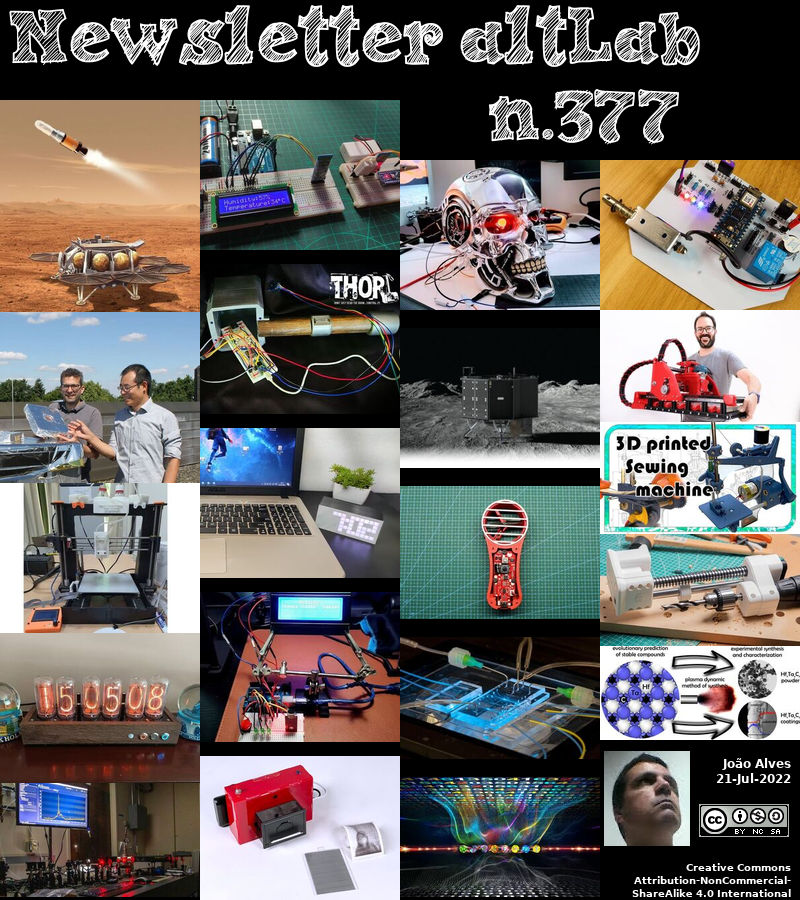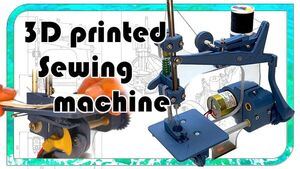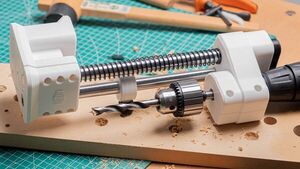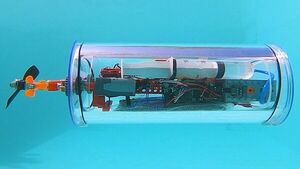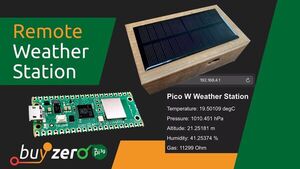2022-07-21 - Nº 377
Editorial
Esta é a Newsletter Nº 377 que se apresenta com o mesmo formato que as anteriores. Se gostar da Newsletter partilhe-a!
Todas as Newsletters encontram-se indexadas no link.
Esta Newsletter tem os seguintes tópicos:
Faz hoje anos que nascia, em 1620, o astrónomo, cartógrafo e engenheiro hidráulico francês Jean Picard. Ele foi considerado como o fundador da astronomia moderna em França. Ele introduziu novos métodos, melhorou os instrumentos antigos, e acrescentou novos dispositivos, tais como o relógio pendular de Huygens para registar tempos e intervalos de tempo. Picard foi o primeiro a utilizar o telescópio para a medição precisa de pequenos ângulos, fazendo uso do micrómetro da Gascoigne. Concebeu um micrómetro de arame móvel para medir os diâmetros de objectos celestes como o Sol, a Lua e os planetas. Para levantamento e nivelamento do terreno, concebeu instrumentos que incorporavam o telescópio astronómico. Picard foi um dos primeiros a aplicar métodos científicos para a elaboração de mapas. Entre as suas outras competências encontrava-se a hidráulica; resolveu o problema de abastecimento de água às fontes de Versalhes. O seu trabalho mais importante foi a primeira medição da circunferência da terra. Utilizou o método de Eratóstenes, mas com maior precisão. Aumentou muito a precisão das medições da Terra, utilizando o método de triangulação de Snell (Mesure de la Terre, 1671). Estes dados foram utilizados por Newton na sua teoria gravitacional. O conceito por detrás dos sinais de néon começou em 1675, quando Picard observou um brilho num barómetro.
Faz também hoje anos que nascia, em 1694, o químico sueco Georg Brandt. Ele foi a primeira pessoa a descobrir um metal desconhecido na antiguidade, que isolou e a quem deu o nome de cobalto (1730). Publicou (1733) descobertas sobre a composição e solubilidade dos compostos de arsénico, tendo depois investigado o antimónio, o bismuto, o mercúrio e o zinco. O seu trabalho sobre métodos de produção de ácidos clorídrico, nítrico e sulfúrico foi publicado em 1741 e 1743. Brandt foi um dos primeiros químicos a forjar completamente a alquimia, e dedicou os seus últimos anos a expor processos alquímicos fraudulentos para a produção de ouro. Os antigos egípcios utilizavam pequenas quantidades de cobalto para tornar o seu vidro azul. O cobalto é adicionado ao aço para o tornar mais duro e ter um ponto de fusão mais elevado. Vestígios dele são encontrados na carne e produtos lácteos como a vitamina B-12.
Faz igualmente hoje anos que nascia, em 1810, o químico e físico francês Henri Victor Regnault. Ele ficou conhecido pelo seu trabalho sobre as propriedades dos gases. O seu inestimável trabalho foi feito como hábil, minucioso e paciente experimentador na determinação do calor específico de sólidos, líquidos, gases, e as tensões de vapor de água e outros líquidos voláteis, bem como o seu calor latente a diferentes temperaturas. Corrigiu a lei de gases de Mariotte relativa à variação da densidade com a pressão, determinou os coeficientes de expansão do ar e outros gases, concebeu novos métodos de investigação e inventou instrumentos precisos. Duas leis que regem o calor específico dos gases têm o seu nome.
Faz também hoje anos que nascia, em 1882, o cientista e engenheiro norte-americano Herbert E. Ives. Ele liderou o desenvolvimento dos sistemas de fac-símile e televisão na AT&T na primeira metade do século XX. É mais conhecido pela experiência Ives-Stilwell de 1938, que confirmou directamente a dilatação temporal da relatividade especial, embora o próprio Ives não tenha aceite a relatividade especial, e tenha defendido uma interpretação alternativa dos resultados experimentais[3]. Ives tem sido descrito como "o oponente mais autoritário da relatividade nos Estados Unidos entre o final dos anos 30 e o início dos anos 50.
Por fim, faz hoje anos que nascia, em 1923, o químico americano nascido no Canadá Rudolph A. Marcus. Ele recebeu o Prémio Nobel da Química de 1992 pelo seu trabalho sobre a teoria das reacções de transferência de electrões em sistemas químicos. A teoria de Marcus descreve e faz previsões sobre fenómenos tão diversos como a fixação da energia da luz por plantas verdes (fotossíntese), metabolismo celular, produção fotoquímica de combustível, quimioluminescência ("luz fria"), a condutividade dos polímeros condutores eléctricos, corrosão, a metodologia da síntese e análise electroquímica, e muito mais.
Uma colaboração internacional de cientistas do Laboratório Nacional de Aceleradores Fermi do Departamento de Energia anunciou a 21 de Julho de 2000, a primeira prova directa da partícula subatómica chamada tau neutrino, o terceiro tipo de neutrino conhecido dos físicos de partículas. Eles relataram quatro casos de um neutrino interagindo com um núcleo atómico para produzir uma partícula carregada chamada tau lepton, a assinatura de um tau neutrino.
A 21 de Julho de 2011, o programa de vaivém espacial da NASA completa a sua missão final, e a 135ª, quando o vaivém Atlantis aterra no Kennedy Space Center na Florida. Durante os 30 anos de história do programa, os seus cinco vaivéns - Columbia, Challenger, Discovery, Atlantis e Endeavour - transportaram mais de 350 pessoas para o espaço e voaram mais de 500 milhões de milhas, e as tripulações do vaivém realizaram importantes pesquisas, prestaram assistência ao Telescópio Espacial Hubble e ajudaram na construção da Estação Espacial Internacional, entre outras actividades. A NASA retirou os vaivéns para se concentrar num programa de exploração do espaço profundo que poderia um dia enviar astronautas para os asteróides e Marte.
Na Newsletter desta semana apresentamos diversas noticias, artigos científicos, projetos de maker e alguns vídeos interessantes.
 João Alves ([email protected])
João Alves ([email protected])
O conteúdo da Newsletter encontra-se sob a licença  Creative Commons Attribution-NonCommercial-ShareAlike 4.0 International License.
Creative Commons Attribution-NonCommercial-ShareAlike 4.0 International License.
Novidades da Semana
Outras Notícias

Samsung Electronics Develops Second-Generation SmartSSD Computational Storage Drive With Upgraded Processing Functionality
"Cuts processing time by over 50%, energy consumption by up to 70% and CPU utilization by up to 97% compared to conventional SSD drives Samsung Electronics, the world leader in advanced memory technology, today announced that it has successfully developed a second generation of its pioneering SmartSSD. The new proprietary computational storage incorporates data processing functionality within a high-performance SSD. Unlike existing SSDs, Samsung’s SmartSSD can process data directly, thereby minimizing data transfers between the CPU, GPU and RAM. This technology can avoid the bottlenecks that often occur when moving data between storage devices and CPUs, resulting in markedly improved system performance and much higher energy efficiency. The SmartSSD is playing an increasingly important role, especially with the growth of next-generation technologies such as AI, machine learning and 5G/6G, which require large amounts of data processing. Leveraging software and intellectual property (IP) developed by customers, along with in-built Arm cores, Samsung’s second-generation SmartSSD enables much more efficient data processing." [...]
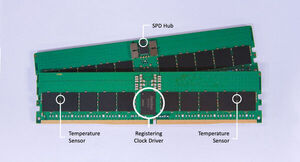
Rambus Expands Portfolio of DDR5 Memory Interface Chips for Data Centers and PCs
" Rambus Inc. (NASDAQ: RMBS), a premier chip and silicon IP provider making data faster and safer, today announced the expansion of its DDR5 memory interface chip portfolio with the addition of the Rambus SPD (Serial Presence Detect) Hub and Temperature Sensor, complementing the industry-leading Rambus Registering Clock Driver (RCD). DDR5 achieves greater memory bandwidth and capacity by employing a new module architecture with an expanded chipset. The SPD Hub and Temperature Sensors improve DDR5 Dual Inline Memory Module (DIMM) system management and thermal control to deliver higher performance within the desired power envelope for servers, desktops and laptops. “The new performance levels of DDR5 memory place an increased premium on signal integrity and thermal management for server and client DIMMs,” said Sean Fan, chief operating officer at Rambus. “With over 30 years of memory subsystem design experience, Rambus is ideally positioned to deliver DDR5 chipset solutions which enable breakthrough bandwidth and capacity for advanced computing systems.” “The strong collaboration between Intel and SPD ecosystem partners like Rambus, delivers critical chip solutions for Intel’s next generation DDR5-based systems, scaling server, desktop and laptop performance to new levels,” said Dr. Dimitrios Ziakas, VP of Memory and IO Technologies at Intel. “Our joint efforts to advance DDR5-based computing systems is setting the stage for Intel’s DDR5 advance over multiple generations and the next level of performance for data centers and consumers.” “DDR5 provides a significant increase in performance for computing systems,” said Shane Rau, research vice president, Computing Semiconductors at IDC." [...]
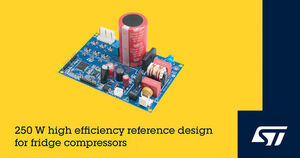
Motor-drive reference designs from STMicroelectronics include STSPIN32 and production-ready PCB
"STMicroelectronics has released two reference designs that simplify building complete industrial or home-appliance motor drives for compressors with the STSPIN32 motor-control system-in-package (SiP). Each integrates the motor controller with a three-phase inverter to power the motor, and an offline converter and auxiliary circuitry. A production-ready PCB design and motor-control firmware are also included. The STEVAL-CTM011V1 targets general industrial compressors up to 250W, while the STEVAL-CTM012V1 meets the stringent eco-design regulations for use in home appliances. The plug-and-play reference designs combine easily with a host system to start driving a motor and allow customers to fine-tune settings for optimal performance. Both ensure average efficiency greater than 96.5%." [...]

NASA Selects Draper to Fly Research to Far Side of Moon
"NASA has awarded Draper of Cambridge, Massachusetts a contract to deliver Artemis science investigations to the Moon in 2025. The commercial delivery is part of NASA’s Commercial Lunar Payload Services (CLPS) initiative under Artemis. Draper will receive $73 million for the contract, and is responsible for end-to-end delivery services, including payload integration, delivery from Earth to the surface of the Moon, and payload operations. This award is the eighth surface delivery task award issued to a CLPS vendor. “This lunar surface delivery to a geographic region on the Moon that is not visible from Earth will allow science to be conducted at a location of interest but far from the first Artemis human landing missions,” said Joel Kearns, deputy associate administrator for exploration in NASA’s Science Mission Directorate in Washington. “Understanding geophysical activity on the far side of the Moon will give us a deeper understanding of our solar system and provide information to help us prepare for Artemis astronaut missions to the lunar surface.” The experiments riding on Draper’s SERIES-2 lander are headed to Schrödinger Basin, a large lunar impact crater on the far side of the Moon, close to the lunar South Pole." [...]

Dual 200mA op amp from STMicroelectronics drives power-hungry industrial and automotive loads
"The STMicroelectronics TSB582 dual high-output amplifier simplifies circuitry for driving inductive and low-ohmic loads like motors, valves, and rotary resolvers in industrial applications and automotive systems such as steer-by-wire and auto-parking. The TSB582 operates from 4V-36V supplies and contains two operational amplifiers (op amps), each capable of sinking/sourcing up to 200mA. This enables direct connection of a load in bridge-tied mode, allowing one TSB582 to replace two single-channel power op amps or high-current drivers built from discrete components. While integrating two op amps into one package, the TSB582 is able to save up to 50% of board space and lowers the bill of materials. Available in industrial- as well as automotive-grade versions, the TSB582 addresses applications such as controlling robot movements and position, conveyor belts, and servo motors. Automotive applications include motor-position sensing including steer-by-wire and electric-traction motors, as well as tracking road-wheel rotation in autonomous driver-assistance systems and self-driving vehicles." [...]
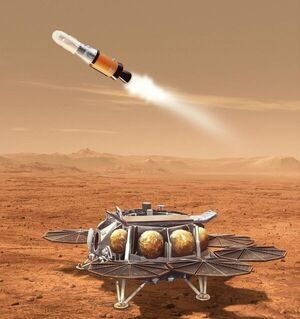
NASA, ESA to Discuss Mars Sample Return Mission
"NASA will host a media teleconference at 11 a.m. EDT (8 a.m. PDT) on Wednesday, July 27, to discuss the architecture for its Mars Sample Return campaign. NASA and the ESA (European Space Agency) recently held a systems requirement review as part of the Mars Sample Return campaign’s conceptual design phase – a phase when the architecture is refined and solidified. The briefing will present the architecture proposal that is expected to be finalized in September 2022. The Mars Sample Return campaign may revolutionize humanity’s understanding of Mars by returning scientifically selected samples for study using the most sophisticated instruments around the world. This strategic partnership with ESA will be the first mission to return samples from another planet, including the first launch from the surface of another planet. The samples to be returned – currently being collected by Perseverance during its exploration of Jezero Crater, home to an ancient river delta – are thought to be the best opportunity to reveal the early evolution of Mars, including the potential for life." [...]
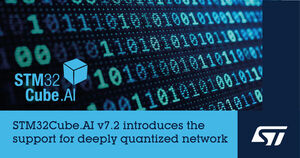
STMicroelectronics extends STM32Cube.AI development tool with support for deeply quantized neural networks
"STMicroelectronics has released STM32Cube.AI version 7.2.0, the first artificial-intelligence (AI) development tool by an MCU (microcontroller) vendor to support ultra-efficient deeply quantized neural networks. STM32Cube.AI converts pretrained neural networks into optimized C code for STM32 microcontrollers (MCUs). It is an essential tool for developing cutting-edge AI solutions that make the most of the constrained memory sizes and computing power of embedded products. Moving AI to the edge, away from the cloud, delivers substantial advantages to the application. These include privacy by design, deterministic and real-time response, greater reliability, and lower power consumption. It also helps optimize cloud usage." [...]
Ciência e Tecnologia

Reducing energy consumption: Bayreuth researchers develop test system for passive cooling materials
"Passive day cooling is a promising technology for the sustainable reduction of energy consumption. It avoids the heating up of buildings by solar radiation and dissipates accumulated heat without external energy consumption. Researchers at the University of Bayreuth have now created a test system with which the materials used for passive cooling can be reliably characterised and compared - regardless of weather conditions and environmental conditions. The measurement setup presented in "Cell Reports Physical Science" is the first step towards a standardised, globally applicable test system for comparing high-performance cooling materials. "Increasing fossil energy consumption worldwide is still contributing to global warming and is a major cause of the heating up of our cities. Cooling buildings during the day using passive cooling materials has great potential to establish itself as an effective tool for energy conservation." [...]

NREL Researchers Create Order From Quantum Chaos
"In a new paper in PNAS, "Triplet-Pair Spin Signatures From Macroscopically Aligned Heteroacenes in an Oriented Single Crystal," National Renewable Energy Laboratory (NREL) researchers Brandon Rugg, Brian Fluegel, Christopher Chang, and Justin Johnson tackle one of the fundamental problems in quantum information science: how to produce pure elements of quantum information—that is, those that start and remain in a well-defined "spin state"—at practical temperatures. Quantum information science has the potential to revolutionize computation, sensing, and communications. But many of these applications are still beyond reach because of the challenges of producing units of quantum information, or qubits, without relying on extremely low temperatures to maintain their purity. Current approaches to identifying suitable quantum materials tend to rely on trial and error. "The field of developing new molecules and materials [for quantum information science] sometimes progresses through ad hoc methods and serendipity. 'This material just so happens to work better than the other one'—we saw a lot of that happening, and decided ultimately that it was not going to suffice for a project where the goal was to limit the set of possible options," said Justin Johnson, a researcher in NREL's Chemistry and Nanoscience Center." [...]
The best semiconductor of them all?
"Researchers have found a material that can perform much better than silicon. The next step is finding practical and economic ways to make it. Silicon is one of the most abundant elements on Earth, and in its pure form the material has become the foundation of much of modern technology, from solar cells to computer chips. But silicon’s properties as a semiconductor are far from ideal. For one thing, although silicon lets electrons whizz through its structure easily, it is much less accommodating to “holes” — electrons’ positively charged counterparts — and harnessing both is important for some kinds of chips. What’s more, silicon is not very good at conducting heat, which is why overheating issues and expensive cooling systems are common in computers." [...]
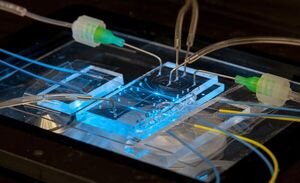
New Device Design Brings Unparalleled Confidence to Cell Measurements
"Measuring the numbers and properties of cells moving in a stream — a process called flow cytometry — is critically important to diagnostic medicine, pharmaceutical research and biomedical science. Now researchers at the National Institute of Standards and Technology (NIST) have devised a way to make unprecedented improvements in the technique. Flow cytometry typically entails marking cells with fluorescent material, shining laser light on them as they cross one particular point in a fluid channel about the size of a human hair — narrow enough that the cells generally move in single file — and recording the light emitted by the markers on the cell. Analyzing the emissions reveals various characteristics such as cell type, size, DNA content, and stage in the cell-division cycle. But the conventional single-measurement method lacks a means to quantify the variations in its readings. For example, a cytometer that measures cancer biomarkers may use a specific measurement value to decide between healthy or diseased cells." [...]

Robots Learn Household Tasks by Watching Humans
"Novel Method Developed by CMU Researchers Allows Robots To Learn in the Wild. The robot watched as Shikhar Bahl opened the refrigerator door. It recorded his movements, the swing of the door, the location of the fridge and more, analyzing this data and readying itself to mimic what Bahl had done. It failed at first, missing the handle completely at times, grabbing it in the wrong spot or pulling it incorrectly. But after a few hours of practice, the robot succeeded and opened the door. "Imitation is a great way to learn," said Bahl, a Ph.D. student at the Robotics Institute (RI) in Carnegie Mellon University's School of Computer Science." [...]
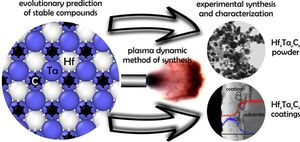
Russian physicists demonstrate inexpensive synthesis of high-melting-point carbide materials
"Researchers from Skoltech and Tomsk Polytechnic University have used an unusual technique from the aerospace industry to synthesize hafnium-tantalum carbide, a hard-to-melt material for coating electrical and mechanical components that operate under extreme conditions. Inexpensive and effective, their plasma dynamic method can produce high-quality carbide both as powders and as coatings on diverse substrates. The research findings are reported in Advanced Functional Materials. Transition-metal carbides are industrially important materials with ultrahigh melting temperatures, impressive hardness and wear resistance. Among them, the carbides of hafnium and tantalum can withstand the highest temperatures — close to 4,000 degrees Celsius — without melting. Interestingly, some of the mixed carbides of these two metals hold the promise of an even higher melting point, making hafnium-tantalum carbides potentially useful for hardware and electronics operating under extreme conditions." [...]

An engineer uses an ancient art to solve a very modern problem
"Stanford aerospace engineer Manan Arya shows how origami can help allow enormous spacecraft structures to fit into rockets a fraction of their size. If you’ve ever made an origami paper crane, using folds and creases to transform a square piece of craft paper into the delicate long-necked bird, it may seem odd that those same folding techniques are being used to develop structures used in one of the most advanced areas of modern technology: space missions. Yet aerospace engineers have turned to the millenary art of origami to solve a serious conundrum: How do you fit massive structures, like shields that can block starlight and sails that can help propel spacecraft, into the significantly smaller rockets that carry these structures into space? While the sizes of each of these structures vary, picture yourself trying to fit a beach umbrella with a 28-meter diameter (about the length of a basketball court) into a minivan. Figuring out the answer to this question is central to enabling future space missions that will one day search for Earth-like exoplanets and spacecraft that will better measure the Earth system using radar remote-sensing. And at the forefront of using the principles of origami to discover potential solutions for this problem is aerospace engineer Manan Arya." [...]

Physicists use quantum simulation tools to study, understand exotic state of matter
"Thomas Iadecola worked his way through the title of the latest research paper that includes his theoretical and analytical work, patiently explaining digital quantum simulation, Floquet systems and symmetry-protected topological phases. Then he offered explanations of nonequilibrium systems, time crystals, 2T periodicity and the 2016 Nobel Prize in Physics. Iadecola’s corner of quantum condensed matter physics – the study of how states of matter emerge from collections of atoms and subatomic particles – can be counterintuitive and needs an explanation at most every turn and term. The bottom line, as explained by the Royal Swedish Academy of Sciences in announcing that 2016 physics prize to David Thouless, Duncan Haldane and Michael Kosterlitz, is that researchers are revealing more and more of the secrets of exotic matter, “an unknown world where matter can assume strange states.” The new paper published in the journal Nature and co-authored by Iadecola, an Iowa State University assistant professor of physics and astronomy and an Ames National Laboratory scientist, describes simulations using quantum computing that enabled observation of a distinctive state of matter taken out of its normal equilibrium. The paper’s corresponding author is Dong-Ling Deng of Tsinghua University in Beijing, China. Deng and Iadecola worked together in 2017 and ‘18 as postdoctoral researchers at the University of Maryland." [...]
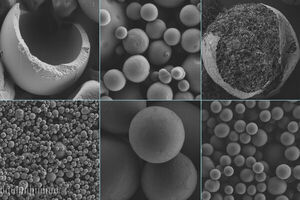
Silk offers an alternative to some microplastics
"Researchers have developed a biodegradable system based on silk to replace microplastics added to agricultural products, paints, and cosmetics. Microplastics, tiny particles of plastic that are now found worldwide in the air, water, and soil, are increasingly recognized as a serious pollution threat, and have been found in the bloodstream of animals and people around the world. Some of these microplastics are intentionally added to a variety of products, including agricultural chemicals, paints, cosmetics, and detergents — amounting to an estimated 50,000 tons a year in the European Union alone, according to the European Chemicals Agency. The EU has already declared that these added, nonbiodegradable microplastics must be eliminated by 2025, so the search is on for suitable replacements, which do not currently exist. Now, a team of scientists at MIT and elsewhere has developed a system based on silk that could provide an inexpensive and easily manufactured substitute. The new process is described in a paper in the journal Small, written by MIT postdoc Muchun Liu, MIT professor of civil and environmental engineering Benedetto Marelli, and five others at the chemical company BASF in Germany and the U.S." [...]

Oxygen effects on uranium tested
"A team of researchers from Lawrence Livermore National Laboratory (LLNL) and the University of Michigan has found that the rate of cooling in reactions dramatically affects the type of uranium molecules that form. The team’s experimental work, conducted over about a year-and-a-half starting in October 2020, attempts to help understand what uranium compounds might form in the environment after a nuclear event. It has recently been detailed in Scientific Reports, a Nature-affiliated publication. “One of our most important findings was learning that the rate of cooling affects the behavior of uranium,” said Mark Burton, the paper’s lead author and a chemist in the Lab’s Materials Science Division. “The big picture here is that we want to understand uranium chemistry in energetic environments.” In their experiments, the LLNL and Michigan researchers found that the rate of cooling — as well as the amount of oxygen — dramatically affect how uranium combines with oxygen. The recent experiments showed that as uranium cools from a plasma at about 10,000 degrees Celsius in microseconds (millionths of a second), the chemistry is drastically different when compared to cooling over milliseconds (thousandths of a second)." [...]

Quantum computer works with more than zero and one
"For decades computers have been synonymous with binary information – zeros and ones. Now a team at the University of Innsbruck, Austria, realized a quantum computer that breaks out of this paradigm and unlocks additional computational resources, hidden in almost all of today’s quantum devices. We all learn from early on that computers work with zeros and ones, also known as binary information. This approach has been so successful that computers now power everything from coffee machines to self-driving cars and it is hard to imagine a life without them. Building on this success, today’s quantum computers are also designed with binary information processing in mind. “The building blocks of quantum computers, however, are more than just zeros and ones”, explains Martin Ringbauer, an experimental physicist from Innsbruck, Austria." [...]
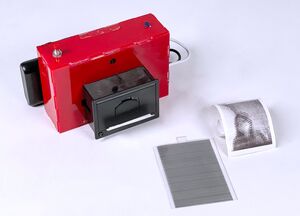
A new twist on old-school animation
"MIT researchers create KineCAM, an instant camera that yields images that appear to move. It’s another case of a class project that turned into a bit more than the typical assignment. The story began last fall in the MIT course 6.810 (Engineering Interactive Technologies) taught by Stefanie Mueller, an associate professor in MIT’s Department of Electrical Engineering and Computer Science. The students, who were mostly undergraduates, were asked to do a final group project, and they were assisted in this effort by graduate students who were helping Mueller teach the course. Now, the product of this effort, along with an accompanying paper, will be presented in August in Vancouver, Canada, at SIGGRAPH 2022, “the world’s largest, most influential annual conference in computer graphics and interactive techniques.” Ticha Sethapakdi, a third-year PhD student based at MIT’s Computer Science and Artificial Intelligence Laboratory, thought hard about a task that could be accomplished in a couple of months and would also enable students to utilize the skills they’d learned in class. Perhaps they could develop an instant camera, she thought, but instead of following the Polaroid example, it might be fun to make a camera that produced moving images." [...]

With fault tolerance the ultimate goal, error mitigation is the path that gets quantum computing to usefulness
"Quantum error mitigation is the continuous path that will take us from today’s quantum hardware to tomorrow’s fault-tolerant quantum computers. This path will let us run larger circuits needed for quantum advantage, one hardware improvement at a time. The history of classical computing is one of advances in transistor and chip technology yielding corresponding gains in information processing performance. Although quantum computers have seen tremendous improvements in their scale, quality and speed in recent years, such a gradual evolution seems to be missing from the narrative. Indeed, it is widely accepted that one must first build a large fault-tolerant quantum processor before any of the quantum algorithms with proven super-polynomial speed-up can be implemented. Building such a processor therefore is the central goal for our development." [...]

Designer Materials to Keep Plastic Out of Landfills
"Berkeley Lab technology provides low-carbon manufacturing solution for plastic products. Scientists have designed a new material system to overcome one of the biggest challenges in recycling consumer products: mixed-plastic recycling. Their achievement will help enable a much broader range of fully recyclable plastic products and brings into reach an efficient circular economy for durable goods like automobiles. We generate staggering quantities of plastic and plastic-containing products each year, but only a tiny fraction of that plastic can be recovered and used to manufacture products of similar quality. That’s because most products, from food-packaging films and single-use bags to sneakers and electronics, are made from mixtures of different plastics, and once they are mixed, those plastics can’t be recovered and used to make new bags or sneakers. Instead, most of it ends up in landfills, incinerators, or oceans." [...]

Grid (un)locked: Carbon-neutral future depends on updating how we make, move and store electricity
"In the push to decarbonize the economy throughout the Intermountain West and beyond, the public conversation often centers on wind and solar energy, electric cars, hydrogen power and carbon capture and storage. The grid — the interconnected power plants, transmission lines and control centers that keep the lights on across the country — is the indispensable enabler of this future carbon-neutral electrified world. Yet the grid is often left out of the discussion. It shouldn’t be. “Achieving this carbon-neutral future requires big changes to the grid, both in its design and overall capacity, storage and reserves as we use more electricity for everything from cars to home heating,” said Mary Ewers, an energy and economics researcher at Los Alamos National Laboratory who has studied the grid for over a decade. “Achieving that future also depends on science to inform the public and decision makers about the options, so they support and make the best choices at all levels, from community to state to region.” Place-based solutions Ewers leads the Electricity thrust within the Intermountain West Energy Sustainability and Transitions initiative, or I-WEST." [...]

Researchers Propose New Multipolar Lattices for Improved Metasurfaces
"Scientists from ITMO University’s Faculty of Physics have predicted a unique type of bound states in the continuum – one that is completely resistant to changes in the system parameters. This would allow researchers to control the resonance properties of metasurfaces and, eventually, to develop more efficient optical and optoelectronic devices of the next generation. The corresponding paper received special recognition from the editors of Physical Review B (Letter) and was published in the section Editor’s Suggestion. Resonators are some of the most widespread and important elements of practically any type of optical or optoelectronic devices. Their basic principle is based on – in the same way that musical instruments amplify soundwaves, so do optical resonators amplify light. But to create optical devices, researchers must first create resonators that can be produced using a – in this way they can be made a component of, for instance, an integrated optical microchip." [...]
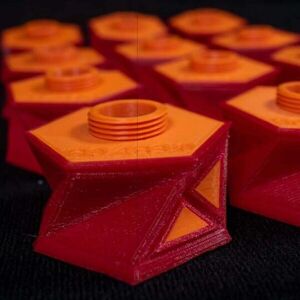
Complex motions for simple actuators
"Inflatable actuators use origami principles to deform in intricate ways. Inflatable soft actuators that can change shape with a simple increase in pressure can be powerful, lightweight, and flexible components for soft robotic systems. But there’s a problem: These actuators always deform in the same way upon pressurization. To enhance the functionality of soft robots, it is important to enable additional and more complex modes of deformation in soft actuators. Now, researchers from the Harvard John A. Paulson School of Engineering and Applied Sciences (SEAS) have taken inspiration from origami to create inflatable structures that can bend, twist and move in complex, distinct ways from a single source of pressure. The research was published in Advanced Functional Materials." [...]

Why Jupiter doesn’t have rings like Saturn
"Because it’s bigger, Jupiter ought to have larger, more spectacular rings than Saturn has. But new UC Riverside research shows Jupiter’s massive moons prevent that vision from lighting up the night sky. “It’s long bothered me why Jupiter doesn’t have even more amazing rings that would put Saturn’s to shame,” said UCR astrophysicist Stephen Kane, who led the research. “If Jupiter did have them, they’d appear even brighter to us, because the planet is so much closer than Saturn.” Kane also had questions about whether Jupiter once had fantastic rings and lost them. It is possible for ring structures to be temporary. To understand the reason Jupiter currently looks the way it does, Kane and his graduate student Zhexing Li ran a dynamic computer simulation accounting for the orbits of Jupiter’s four main moons, as well as the orbit of the planet itself, and information about the time it takes for rings to form." [...]

Computational technology molding a grand future in architecture
"The future of architecture is here, with RMIT experts and technology revolutionising how we treat everyday building materials. A concept so new, Australia's Grand Designs couldn't stay away when it was put to the test. Through engaging RMIT’s Tectonic Formations Lab, Senior Lecturer and architect Ben Milbourne demonstrated how emerging technologies can transform traditional building practices, using his own home as a proof-of-concept test for his practice-based research Phd in Architecture and Urban Design. “I used the project as a model for rethinking how we treat building facades, in this case how surface articulation around windows and doors is increased to draw visual attention and deflect water away from openings.” "I was looking at some of the work my colleagues were exploring in computational design and fabrication techniques in construction, and how I would be able to use some of these techniques in different materials such as concrete." Milbourne’s work has meticulously explored the challenges and opportunities that arise out of the increasing adoption of digital fabrication within the design and construction industries in Australia. “I used a computational design technique that simulates magnetic fields to produce a pattern that was able to deflect water away from the windows in a non-traditional way." [...]

Astronomers develop novel way to ‘see’ the first stars through the fog of the early Universe
"A team of astronomers has developed a method that will allow them to ‘see’ through the fog of the early Universe and detect light from the first stars and galaxies. The researchers, led by the University of Cambridge, have developed a methodology that will allow them to observe and study the first stars through the clouds of hydrogen that filled the Universe about 378,000 years after the Big Bang. Observing the birth of the first stars and galaxies has been a goal of astronomers for decades, as it will help explain how the Universe evolved from the emptiness after the Big Bang to the complex realm of celestial objects we observe today, 13.8 billion years later. The Square Kilometre Array (SKA) - a next-generation telescope due to be completed by the end of the decade - will likely be able to make images of the earliest light in the Universe, but for current telescopes the challenge is to detect the cosmological signal of the stars through the thick hydrogen clouds. The signal that astronomers aim to detect is expected to be approximately one hundred thousand times weaker than other radio signals coming also from the sky – for example, radio signals originating in our own galaxy. Using a radio telescope itself introduces distortions to the signal received, which can completely obscure the cosmological signal of interest." [...]
Projetos Maker
Diversos Projetos interessantes.
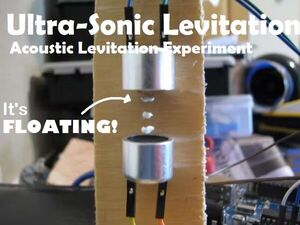
Ultrasonic Levitation | Acoustic Levitation Experiment
"Anti-Gravity, it's not real. it's a fake thing made up in sci-fi movies and stuff. it's NOT real.... Or is it? using ultrasonic frequency sound, you can levitate small objects, The Acoustic levitator is two high frequency speakers pointed at each other. When one speaker is on, it creates forces going in the direction it's pointed at. when they're both pointed at each other the two forces push at each other, and when a small object is is between the two forces it can cause it to levitate." [...]
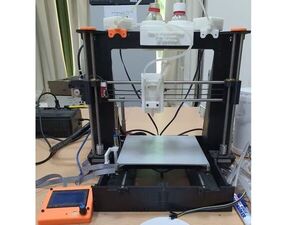
DIY 3D Bio-printer
"Fabrication of a 3D bio-printer from an off-shelf 3D printer (Prusa). The bioprinter is used for constructing 3D scaffold from hydrogels The story Additive manufacturing tech such as 3D printing is the manufacturing process to obtain physical objects from CAD files, through adding layer-by—layer of a specific material (Haleem, et al., 2019; Chen, et al., 2020). 3D printing has had a rising progress which led to the development of revolutionary field called 3D bio-printing (Sanchez, et al., 2020; Vanaei, et al., 2021). In this research, we are introducing an approach to a low cost DIY 3D-Bioprinter converted from an Off-shelf 3D printer. Later, 3D bio-printing strategies are introduced using a mixture of natural polymers in hydrogel to produce a simple scaffolds. Followed by their application in the medical field." [...]
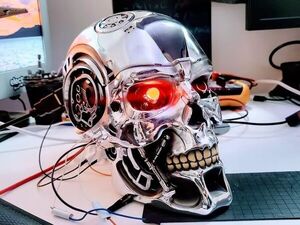
Terminator Skull
"A T-800 skull that can talk, listen and detect humans/objects using ML. The Skynet funding bill is passed. 314Reactor, the creator which made the machines, made two Terminator skulls with a single board computer. Their mission: to make a cool Terminator head that uses machine learning to see and talk. The first Terminator was The Raspbinator, in the year 2018... before the Raspberry Pi 4. It was pretty cool." [...]

Arduino 'Knock Knock' Door Access System
"Use 'secret knocks' to enter a room! I was watching Stranger Things Season 2, there was a scene where one of the characters in the show was using a secret knock on the door to let the other person in the house know it was him. At this point, I know I have a peculiar interest in making very 'puzzling' projects haha 🤣 Then I recalled I have a digital/analog sound sensor lying around. Hence, this project was created in a span of three days! I really hope someone could implement it much better than I do since I have very limited resources (and space in the house) to do this. Do watch the video below to see how it works!" [...]

Display for PC RAM, VRAM, CPU & GPU with gauges
"Instead of having numbers floating around your screen to see your pc performance, here you can use an arduino with lcd to display it to you Story if you have an arduino laying around with an LCD display, you can use it to monitor your pc performance, just like task manager or like MSI Afterburner. in this case, I design it to display RAM, VRAM, CPU & GPU of my PC. it just nice you know to see it fluctuates over time, especially if you open a spec demanding software like video editor or even some games. first, my bad for not using i2c for the lcd. I dont have it, and the shipping price is 3x the device price itself, so whatever. you can tweak the code and schematic by yourself if you have it." [...]
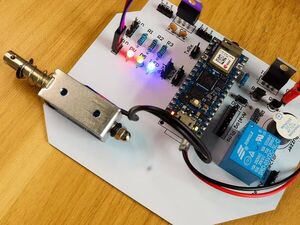
Voice Controlled Door Lock using Alexa and Arduino
"We're going to build an Alexa-controlled door locking system in this video so that we can lock and unlock a door with just our voices. Story Voice Controlled Door Lock: An Overview Hey, everyone! Welcome back. In this video, we'll make an Alexa-controlled door locking system that lets us lock and unlock a door with our voices. This lock is easy to design, make, install, and use. Not only do they make your home safer and more convenient, but they also make it easier to install and use locks in general." [...]

Picodeck
"Firmware using tinyusb to turn a Raspberry Pi Pico into a device that works with Elgato's Stream Deck software. " [...]

Digital Tachometer
"The project is about the design of a digital tachometer, a device used in the measurement of speeds of rotating bodies. Story A tachometer is a gadget that is used in the measurement of angular speeds of bodies, more so bodies in rotary motion example is the shaft of a motor. The units used by the tachometer are rev/min, ft/min, or m/sec. The tachometer is also used in the measurement of distance or length. Here the units used are meters, yards, or feet. An example of a tachometer is the car speedometer." [...]
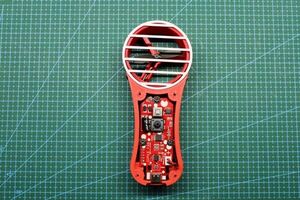
DIY Handheld Fan
"Made a DC Handheld Fan from scratch using 3D Printed parts and a custom PCB. An Attiny13A powers the whole setup. I prepared a 3D Printed body and made a custom PCB that holds all the essential electronics on it that drives the main motor, I'm using Micro Brushed DC Motor here which is generally used in Micro Drones, It's loud and super powerful. As for the brain of this project, I used an Attiny13A to control a Mosfet IC that drives the DC motor. Its operation is simple, we first turn ON this setup by pressing the ON-OFF Switch. next, we press the toggle switch to start the FAN." [...]

Smart Bluetooth HC-05 controlled Power Strip
"Timer based smart power strip which can be controlled over bluetooth using mobile application. Story Problem Definition Overnight charging devices like mobile, Power banks and Trimmer causes an overcharging issue if not turned off on time. Problem Solution We need to have some system that will automatically turn off the supply to the devices—a timer-based power strip that will turn off itself after the expiry of the preset time. Implemented timer-based power strip which can be controlled using the mobile application over Bluetooth. Users can set the desired time using the application to start the power strip which will automatically turn off after the timer expiry. Hardware Interfacing - Connect 4 channel relay module's IN1 to IN4 pins to UNO's 8 to 11 pin respectively - Connect VCC and GND of relay module to the UNO's 5v and GND pin respectively - Connect HC-05 module's VCC and GND to the UNO's 5v and GND pin respectively - Connect the Tx and Rx pin of the HC-05 module to the Rx and Tx pin of UNO (PS: Cross connection)." [...]

Arduino Nano 33 IoT Modular Nixie Clock with Web UI
"USB 5V or 12V, Motion, Light, Temperature, Humidity & Pressure Sensors. NTP Sync, Web Interface for changing settings/time & wifi. The story *** Caution the PSU can output high DC voltages, can cause serious injury *** I'm a bit late to the Nixie Party but I finally made it here. This Nixie Clock is a bit different from the others; it runs using an Arduino Nano 33 IoT, has a motion sensor, light sensor, temperature, humidity & barometric pressure sensor and runs from 5V USB or 12V. It has a web interface for changing settings and syncs the time using NTP. Before I got to the final product, I had spent a lot of time making a Shift Register version with transistors and multiplexing, this worked on the breadboard however I got severe ghosting when I made the PCBs." [...]
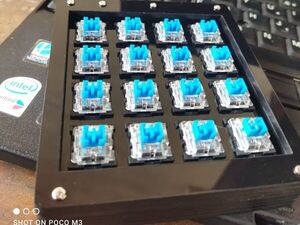
Xiao NAH Macropad
"A macropad built around the xiao footprint. Introduction After successfully trying to build my own mechanical keyboard using other people PCB design. I want to try to design my own keyboard but before I go there I want to start to design something simple. So I try to design a macro pad 1st. My requirement for the macro pad are it need to be 4x4 switch to replace the numpad for my 60% keyboard. Material and Component Selection By the time I am making this project we are in a chip crisis situation, so for this project I choose the RP2040 chip because its still in a stable stock situation." [...]
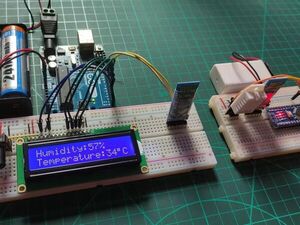
Wireless Temperature and Humidity Monitoring system
"How to make Wireless Temperature and Humidity Monitoring system by Bluetooth | DHT-22 Sensor Components For Transmitter Transmitter Components Details () { Solderless Breadboard, Arduino NaNo, HC-05 Bluetooth Module, DHT-22 Temperature and Humidity Sensor, Male to Male Jumper Wires, Hard Jumper Wire, Battery clip, Battery 9v } Receiver Components Details () { Solderless Breadboard, Arduino UNO, HC-05 Bluetooth Module, 16x2 LCD Display, 10k Variable Resistor, 100R Resistor, Male to Male Jumper Wires, Hard Jumper Wire, Battery clip, Battery 9v }" [...]
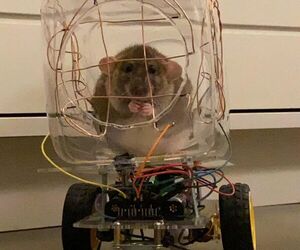
Build a Car With Touch Sensitive Steering for Your Rat
"In 2019 Professor of Behavioral Neuroscience Kelly Lambert and her research colleagues published a journal article called "Enriched Environment Exposure Accelerates Rodent Driving Skills." This article explains "The research team built a tiny car for the rats out of a clear plastic food container on wheels, with an aluminum floor and three copper bars functioning as a steering wheel. A total of 17 rats were trained to drive in rectangular arenas. Rats who passed their driver’s education were rewarded with Froot Loops." Incredibly, the study actually found that rats enjoyed learning how to drive! Now I don't particularly like driving but who am I to deprive my pet rats of that experience?" [...]
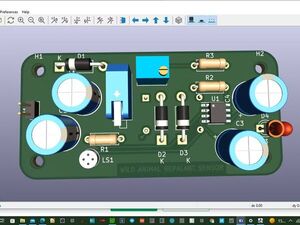
'Wild' Animals Repellant Sensor
"The project is about creating a system that will help you scare away 'Wild' animals like dogs when they are on the attack. Story Any time the term Ultrasonic comes to our mind, we figure out the communication of the dolphins and the bats. Ultrasonic is used to refer to any sound that is beyond the audible sound frequencies and this is something over 20kHz. Some equipment such as the ultra scan systems that are used in the diagnosis of the patient in the medical field extends to sound frequencies of 10MHz and beyond. Our Wild Animal Repellant sensor is a designed system that will be used to scare away angry and attacking dogs. The system is built of a 555-timer integrated circuit, a small ferrite transformer, and a speaker." [...]

THOR Smart Room Controller
"THOR is a STEM toy designed to read temperature and humidity that triggers an alert for a "danger zone" curbing Black Mold growth. Story The project stems from a Deep Dive Coding IoT Bootcamp at CNM Ingenuity in Albuquerque New Mexico. The THOR in concept was created due to my daughters struggle with allergies and living conditions in humid climates. The THOR initiates with an MP3 welcome engagement sound. Once deployed the Hammer starts to read the Temperature in Fahrenheit, Relative Humidity, and Hectopascal for Barometric pressure. The controller alerts the HUE system with changes in temperature and humidity and alerts in Red when conditions are in the "danger zone"." [...]

Simple RGB Desktoclock using ATTINY85
"RGB Desktop clock using ATtiny85 and neopixel I wanted to make a customised clock for my desk. With the help of neopixel LEDs, I decided to build my own digital clock that is good enough to display the time while I am working. in this clock, we can change the time time, digit colour and brightness. so let's get started with the making. Components: - ATtiny 85*1 - WS2812B LEDs *54 - RTC DS1307*1 - AMS1117-5.0*1 - Switch*1 - 10k*1 - Diode_4148*1 - Slide Switch*1 - 32.768kHz crystal oscillator *1 - TP4056 li-ion battery charging module - 18650 li-ion battery First, I selected neopixels for the clock because we need only one pin to control all LEDs and we can simply display different colours. To display a digit we need at least 5 rows and 3 columns of LED." [...]
Secção Videos
Videos interessantes.
That's all Folks!



